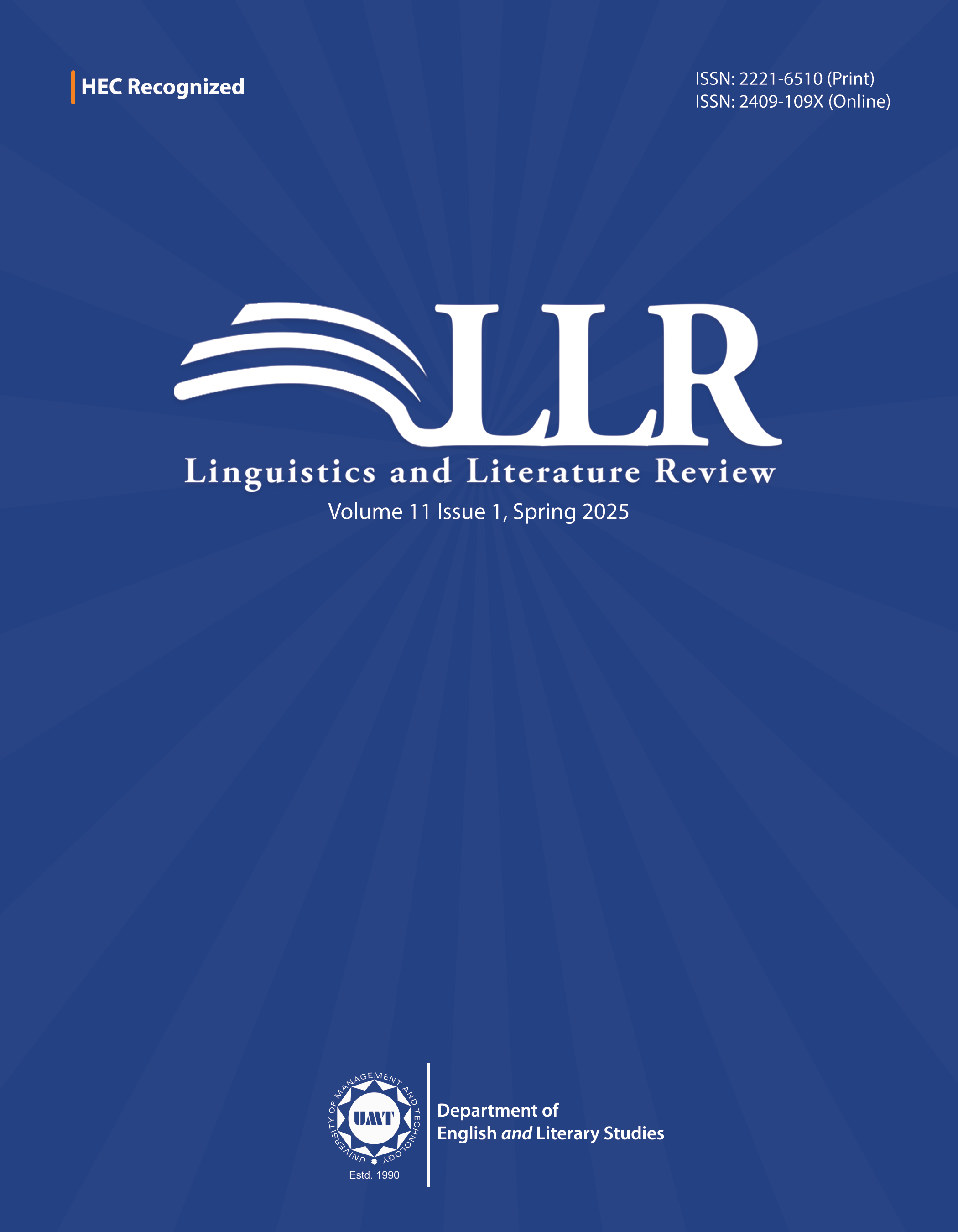Language Shift Phenomenon: A Case Study of Shina Language
Abstract
 Abstract Views: 0
Abstract Views: 0
This study has investigated the domination of English and Urdu over the Shina language, which is spoken in the mountainous regions of Gilgit-Baltistan, Pakistan. It has examined the degree to which Shina speakers have maintained or shifted away from their mother tongue. The data was collected from five Shina-speaking families residing in the Nagar district using purposive sample techniques. These families belong to various walks of life with a diverse representation of experiences. The total pool of the sample includes twenty-six respondents. The data was gathered through 30-minute interviews along with the observations. The recordings were made with the participants’ consent. Subsequently, the recorded data was transcribed into International Phonetic Alphabet (IPA) notation for a one-minute excerpt from each family member. In addition, the observed data were also taken into account during the analysis. The findings revealed that Shina speakers are more inclined towards Urdu than English. The research has specified that older speakers use the Shina language in all domains of their lives, while their children prefer to use English and Urdu.
Downloads
References
Anjum, U., & Siddiqi, A. F. (2012). Exploring attitudinal shift in Pothwari: A study of the three generations. Pakistan Journal of History and Culture, 33(1), 89–117.
Baart, J. L. (2003, September 26–27). Sustainable development and the maintenance of Pakistan’s indigenous languages [Paper presentation]. Proceedings of the Conference on the State of the Social Sciences and Humanities, Islamabad, Pakistan.
Baart, J. L. G., & Sagar, M. Z. (2004). Kalam Kohistani texts. Summer Institute of Linguistics and National Institute of Pakistan Studies. https://tinyurl.com/ysp6ead5
Bashir, E. (2010). Traces of mirativity in Shina. Himalayan Linguistics, 9(2), 1–35. https://doi.org/10.5070/H99223478
Biddulph, J. (1985). Dialects of tribes of the Hindu Koosh. Cambridge University Press.
Blau, P. M. (1956). Social mobility and interpersonal relations. American Sociological Review, 21(3), 290–295. https://doi.org/10.2307/2089282
Blommaert, J. (2010). The sociolinguistics of globalization. Cambridge University Press.
Campbell, L., & Muntzel, M. (1994). Language death. The Encyclopedia of Language and Linguistics, 4, 1960–1968.
Crystal, D. (2003). English as a global language. Cambridge University Press.
Dani, A. H. (1991). History of northern areas of Pakistan. National Institute of Historical and Cultural Research.
Fishman, J. A. (1964). Language maintenance and language shift as a field of inquiry. A definition of the field and suggestions for its further development. Journal of Linguistics, 2(9), 30–64.
Grenoble, L. A. (2024). Language loss and endangerment in northern Asia. In E. Vajda (Ed.), The languages and linguistics of Northern Asia: Typology, morphosyntax and socio-historical perspectives (pp. 1211–1232). De Gruyter Brill.
Grimes, B. F. (2001). Global language viability. Endangered Languages of the Pacific Rim, Lectures on Endangered Languages, 2, 45–61.
Hussain, A., Ali, A., & Hussain, M. (2023). The anxiety of speaking English as a second language among students of Karakoram International University, Hunza Campus. USWA Journal of Research, 3(2), 1–22.
Jahan, H. (2014). Language Shift in Wakhi Community: A case study of village Passu, District Hunza-Nagar, Gilgit-Baltistan [Doctoral dissertation, Quaid-i-Azam University]. QAU Research Repository. http://dspace.qau.edu.pk:8080/jspui/handle/123456789/6548
Jettmar, K. (1961). Ethnological research in Dardistan 1958. Preliminary report. Proceedings of the American Philosophical Society, 105(1), 79–97.
Milroy, L. (2000). Social network analysis and language change: Introduction. European Journal of English Studies, 4(3), 217–223. https://doi.org/10.1076/1382-5577(200012)4:3;1-S;FT217
Nazir, B., Aftab, U., & Saeed, A. (2013). Language shift–The case of Punjabi in Sargodha region of Pakistan. Acta Linguistica Asiatica, 3(2), 41–60. https://doi.org/10.4312/ala.3.2.41-60
Paulston, C. B. (1985). Ethnic and national mobilization: Linguistic outcomes. Aila Review, 2, 50–61.
Rehman, K. A., & Baart, L. G. (2005). A first look at the language of Kundal Shahi in Azad Kashmir. SIL Global. https://www.sil.org/system/files/reapdata/10/55/83/10558360034839761273787716304857102032/silewp2005_008.pdf
Sasse, H.-J. (1992). Theory of language death. In M. Brenzinger (Ed.), Language death: Factual and theoretical explorations with special reference to East Africa (pp. 7–30). De Gruyter Brill.
Sökefeld, M. (2014). Anthropology of Gilgit-Baltistan: Introduction. In M. Gandelsman-Trier (Ed.), Anthropology of Gilgit-Baltistan, northern Pakistan (pp. 9–30). Ethno Scripts.
van Aswegen, K. (2008). The maintenance of Maale in Ethiopia. Language Matters, 39(1), 29–48. https://doi.org/10.1080/10228190802321012
Veltman, C. (2014). Language shift in the United States (Vol. 34). Mouton Publisher.
Weinreich, M. (2010). Language shift in northern Pakistan: The case of Domaakí and Pashto. Iran and the Caucasus, 14(1), 43–56.
Copyright (c) 2025 Arif Hussain, Muhammad Nawaz, Sohbat Ali

This work is licensed under a Creative Commons Attribution 4.0 International License.

This work is licensed under a Creative Commons Attribution 4.0 International License. Authors retain copyright and grant the journal right of first publication with the work simultaneously licensed under a Creative Commons Attribution (CC-BY) 4.0 License that allows others to share the work with an acknowledgment of the work’s authorship and initial publication in this journal.







